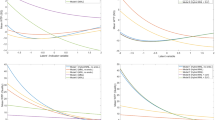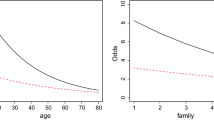Abstract
There is growing interest in establishing a mechanism to account for scale heterogeneity across individuals (essentially the variance of a variance term or the standard deviation of utility over different choice situations), in addition to the more commonly identified taste heterogeneity in mixed logit models. A number of authors have recently proposed a model that recognizes the relationship between scale and taste heterogeneity, and investigated the behavioural implications of accounting for scale heterogeneity in contrast to a term in the utility function, itself. In this paper we present a general model that extends the mixed logit model to explicitly account for scale heterogeneity in the presence of preference heterogeneity, and compare it with models that assume only scale heterogeneity (referred to as the scale heterogeneous multinomial logit model) and only preference heterogeneity. Our empirical assessment suggests that accommodating scale heterogeneity in the absence of accounting for preference heterogeneity may be of limited empirical interest, resulting in a statistically inferior model, despite it being an improvement over the standard MNL model. Scale heterogeneity in the presence of preference heterogeneity does garner favour, with the generalized mixed logit model an improvement over the standard mixed logit model. The evidence herein suggests, however, that compared to a failure to account for preference heterogeneity that is consequential, failure to account for scale heterogeneity may not be of such great empirical consequence in respect of behavioural outputs such as direct elasticities and willingness to pay. However additional studies are required to establish the extent to which this evidence is transferable to a body of studies.



Similar content being viewed by others
Notes
One can however allow for deterministic taste heterogeneity via interaction terms with respondent-specific characteristics.
Extensive development work was undertaken in the design of the CAPI instrument followed by a pre-pilot of 80 respondents. The pre-pilot data was used to estimate a series of multinomial and nested logit models for the pooled data. On the basis of the review of the pilot output, minor changes to the survey instrument were made.
All models are estimated using (pre-release) Nlogit5.
We have found that using start values from mixed logit for GMXL is preferable than using MNL start values.
AIC = 2 k−2Ln(L) where k is the number of parameters in the model, and L is the maximised value of the likelihood function for the estimated model.
The elasticities are based on uncalibrated models and as such the numerical magnitudes are only valid in the comparisons across models. These models cannot be used to forecast patronage without calibration using revealed preference shares on existing modes.
Since all elasticities are negative, a lower value is an absolute lower value (e.g. −0.435 is lower than −0.650).
We also undertook a bootstrap calculation for two of the variables to ensure that the t-ratio test was a useful approximation. The resulting standard errors confirm that the t-ratios are a good approximation.
In this paper all models are estimated in preference space. We have estimated a GMXL model using the same data in WTP space in Hensher and Greene (2009). We report WTP estimates herein (on the request of referees) although this is not the focus of the paper; however the mean estimates for in-vehicle time, access time and egress time in WTP space for GMXL (M3) given in Hensher and Greene (2009) are respectively $16,35, $24.07 and $15.71 per person hour.
Albeit that problems with it going to infinity are slightly less pronounced than say with the uniform bounded at zero, so that a limited simulation may produce apparently reasonable results.
References
Breffle, W.S., Morey, E.R.: Investigating preference heterogeneity in a repeated discrete-choice recreation demand model of Atlantic salmon fishing. Mar. Resour. Econ. 15, 1–20 (2000)
Daly, A., Hess, S., Train, K.: Assuring finite moments for willingness to pay in random coefficient models. Institute for Transport Studies, University of Leeds, UK (2009)
Fiebig, D., Keane, M., Louviere, J., Wasi, N.: The generalized multinomial logit: accounting for scale and coefficient heterogeneity. Mark. Sci. (2009). doi:10.1287/mksc.1090.0508
Fosgerau, M.: Investigating the distribution of the value of travel time savings. Transp. Res. B 40(8), 688–707 (2006)
Fosgerau, M.: Using nonparametrics to specify a model to measure the value of travel time. Transp. Res. A 41(9), 842–856 (2007)
Greene, W.H.: Nlogit 4. Econometric Software, New York and Sydney (2007)
Hensher, D.A.: Attribute processing, heuristics and preference construction in choice analysis. (Invitational Keynote Paper for Choice Modelling Conference, Leeds, UK. March 30–April 1 2009). In: Hess, S., Daly, A. (eds.) State-of Art and State-of Practice in Choice Modelling, pp. 35–70. Emerald Press, UK (2010)
Hensher, D.A., Greene, W.H.: Mixed logit models: state of practice. Transportation 30(2), 133–176 (2003)
Hensher, D.A., Greene, W.H.: Valuation of travel time savings in WTP and preference space in the presence of taste and scale heterogeneity. Institute of Transport and Logistics Studies, University of Sydney, Sydney (2009)
Hensher, D.A., Rose, J.M.: Development of commuter and non-commuter mode choice models for the assessment of new public transport infrastructure projects: a case study. Transp. Res. A 41(5), 428–433 (2007)
Hensher, D.A., Louviere, J.J., Swait, J.: Combining sources of preference data. J. Econ. 89, 197–221 (1999)
Hess, S., Rose, J.M., Bain, S.: Random scale heterogeneity in discrete choice models, mimeo (2009)
Keane, M.: The generalized logit model: preliminary ideas on a research program, presentation at Motorola-CenSoC Hong Kong Meeting, October 22, 2006
Louviere, J., Eagle, T.: Confound it! that pesky little scale constant messes up our convenient assumptions. In: Proceedings, 2006 Sawtooth Software Conference, pp. 211–228. Sawtooth Software, Sequem, Washington, USA (2006)
Louviere, J.J., Meyer, R.J., Bunch, D.S., Carson, R., Dellaert, B., Hanemann, W.M., Hensher, D.A., Irwin, J.: Combining Sources of preference data for modelling complex decision processes. Mark. Lett. 10(3), 205–217 (1999)
Louviere, J.J., Carson, R.T., Ainslie, A., Cameron, T.A., DeShazo, J.R., Hensher, D.A., Kohn, R., Marley, T., Street, D.J.: Dissecting the random component of utility. Mark. Lett. 13, 177–193 (2002)
Louviere, J.J., Street, D., Burgess, L., Wasi, N., Islam, T., Marley, A.A.J.: Modelling the choices of individuals decision makers by combining efficient choice experiment designs with extra preference information”. J. Choice Model. 1(1), 128–163 (2008)
Rose, J.M., Bleimer, M.C.J.: Stated preference experimental design strategies. In D. A. Hensher, & K. J. Button (Eds) Handbook of Transport Modelling, Chap. 8, pp. 151–180. Elsevier, Oxford (2008)
Rose, J.M., Bliemer, M.C., Hensher, Collins, A.T.: Designing efficient stated choice experiments in the presence of reference alternatives. Transp. Res. Part B 42(4), 395–406 (2008)
Scarpa, R., Campbell, D., Hutchinson, W.G.: Benefit estimates for landscape improvements: sequential Bayesian design and respondents’ rationality in a choice experiment study. Land Econ. 83(4), 617–634 (2007)
Scarpa, R., Thiene, M., Train, K.: Utility in willingness to pay space: a tool to address confounding random scale effects in destination choice to the Alps. Am. J. Agri. Econ. 90(4), 994–1010 (2008a). (Also see Appendix: Utility in WTP space: a tool to address confounding random scale effects in destination choice to the Alps. http://agecon.lib.umn.edu/)
Scarpa, R., Thiene, M., Marangon, F.: Using flexible taste distributions to value collective reputation for environmentally-friendly production methods. Can. J. Agri. Econ. 56, 145–162 (2008b)
Sonnier, G., Ainslie, A., Otter, T.: Heterogeneity distributions of willingness to-pay in choice models. Quant. Mark. Econ. 5(3), 313–331 (2007)
Train, K.: Discrete choice methods with simulation. Cambridge University Press, Cambridge (2003)
Train, K., Weeks, M.: Discrete choice models in preference space and willing to-pay space. In: Scarpa, R., Alberini, A. (eds.) Applications of Simulation Methods in Environmental and Resource Economics, Chap. 1, pp. 1–16. Springer Publisher, Dordrecht (2005)
Acknowledgements
The comments of Riccardo Scarpa, John Rose and Chandra Bhat and three referees on earlier versions are appreciated.
Author information
Authors and Affiliations
Corresponding author
Rights and permissions
About this article
Cite this article
Greene, W.H., Hensher, D.A. Does scale heterogeneity across individuals matter? An empirical assessment of alternative logit models. Transportation 37, 413–428 (2010). https://doi.org/10.1007/s11116-010-9259-z
Published:
Issue Date:
DOI: https://doi.org/10.1007/s11116-010-9259-z




